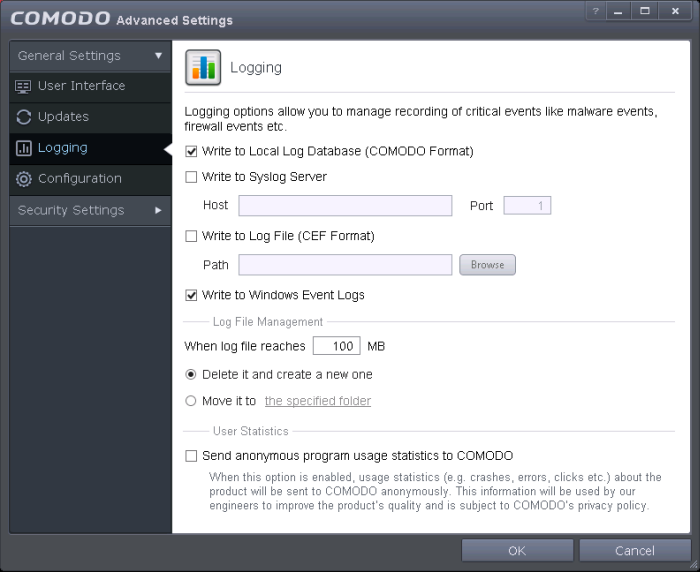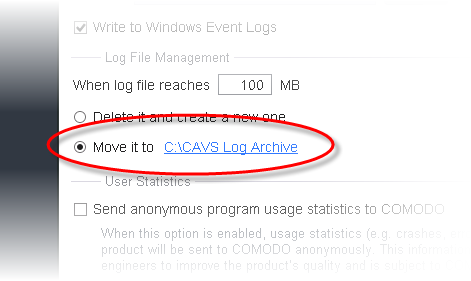Log Settings
By default, Comodo Antivirus for Servers maintains detailed logs of all Antivirus and Defense+ events. Logs are also created for 'Alerts Displayed', 'Tasks Launched' and 'Configuration Changes'.
- This 'Logging' interface allows you to specify whether you want to enable logging; the maximum size of the log file and how CAVS should react if the maximum file size is exceeded.
Note: If you wish to actually view, manage and export logs, then you need to open the 'View CAVS Logs' interface under 'General Tasks' (Tasks > General Tasks > View Logs)

Logging Options
- Write to Local Log Database – Instructs CAVS to store the log files in the local storage of the endpoint in Comodo format so that they can be viewed from Tasks > General Settings > View Logs interface. Refer to the section 'View Logs' for more details. The Log storage depends on the log file management settings configured in the 'Log File Management' settings area in the same interface. (Default = Enabled).
- Write to Syslog Server – Instructs CAVS to forward the log files to an external Syslog Server integrated with the CESM server that remotely manages your CAVS installation. Enter the IP address/hostname of the Syslog server in the Host text field and enter the port through which Syslog server listens to CESM in the 'Port' field (default port = 514). (Default = Disabled).
- Write to Log file (CEF) Format – Instructs CAVS to store the log files at a specified location in the local storage or a network storage, in Common Event Format (CEF) format, also known as NCSA Common Log Format, which is standardized text file format. When selecting this option, click 'Browse', select the storage location and navigate to the log file to which the logs are to be added. (Default = Disabled).
- Write to Windows Event Logs – Instructs CAVS to store the log events to the Windows Event Logs. (Default = Enabled)
- If the log file's size exceeds (Mb) - Enables you to specify behavior when the Local Log Database (Comodo Format) log file reaches a certain size. You can decide on whether to maintain log files of larger sizes or to discard them depending on your future reference needs and the storage capacity of your hard drive.
- Specify the maximum limit for the log file size (in MB) in the text box beside 'If the log file's size exceeds (MB)' (Default = 100MB).
If you want to discard the log file if it reaches the maximum size, select 'Delete it and create a new one'. Once the log file reaches the specified maximum size, it will be automatically deleted from your system and a new log file will be created with the log of events occurring from that instant(Default = Enabled).
If you want to save the log file even if it reaches the maximum size, select 'Move it to' and select a destination folder for the log file (Default = Disabled).

The selected folder path will appear beside 'Move it to'.

Once the log file reaches the
maximum size, it will be automatically moved to the selected folder
and a new log file will be created with the log of events occurring
from that instant.
User Statistics
- Send anonymous program usage (e.g. clicks, crashes, errors etc) statistics to COMODO in order to improve the product's quality - Comodo collects collects the usage details from millions of CAVS users to analyze their usage patterns for the continual enhancement of the product. Your CAVS instillation will collect details on how you use the application and send them periodically to Comodo servers through a secure and encrypted channel. Also your privacy is protected as this data is sent anonymous. This data will be useful to the engineers and developers at Comodo to identify the areas to be developed further for delivering the best Internet Security product. Disable this option if you do not want your usage details to be sent to Comodo (Default = Disabled).



